
|
|

I
took over this e-zine when Gail, its originator was unable to continue it. With
Gail's permission, I have added her original Rock's of the Week so that everyone
can find the information readily. Please feel free to visit Gail's web site at http://www.davesrockshop.com. |
|
Rhodochrosite
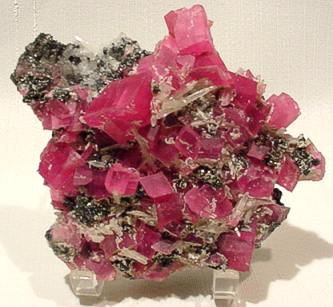
Rhodochrosite from Colorado
|
|
Scientific:
Rhodochrosite is a mineral of the calcite series, its name being derived from the Greek words
rhodos, meaning rose and khros meaning color. Another name for rhodochrosite is raspberry spar or manganese spar. Rhodochrosite is a very attractive mineral with an absolutely one of a kind, beautiful color. Although it can be an ore of manganese, it is it's ornamental and display specimen qualities that make it a very popular mineral. The color of a single crystal can just astound the observer with its vivid pink-rose color that seems to be transmitted out of the crystal as if lit from within. Transparent crystals are very rare. The aggregates are light to dark stripes with zigzag bands. Raspberry red and pink are the most common colors, but it can also be faded pink to slightly orange. Chemical alteration can turn it blackish or dull brown.
Individual crystals are found in well-shaped rhombohedrons (like calcite) and more rarely
scalahedrons. In a massive form its pink and white bands are extremely attractive and are often used in semi-precious jewelry. Rhodochrosite is often carved into figurines and tubular stalactitic forms are sliced into circles with concentric bands that are truly unique in the mineral kingdom. Fine crystals are sometimes cut into gemstones, but rhodochrosite's softness and brittleness limit it as a gemstone for everyday use. |
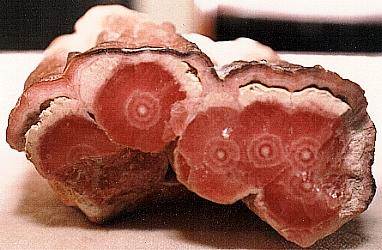
Rhodochrosite stalactites from
Argentina
|
|
Some specimens are transparent but they are very rare and extremely expensive. Most deposits take the form of great lumps (massive aggregates), tiny grains or compacted layers. Rhodochrosite forms in veins of copper, lead and silver which have been altered by hot water (hydro thermals), and as a secondary deposit in sedimentary layers of manganese oxide.
Identification of rhodochrosite is fairly easy despite a few similarly colored minerals such as rhodonite. (Rhodonite is harder and has different cleavage; but perhaps the best distinguishing factor is its lack of reaction to acids.) Rhodochrosite will easily show some reaction to cold acids that demonstrates its carbonate chemistry. Basically, any rose-pink carbonate is considered rhodochrosite; however some calcites with a small amount of manganese impurities can be pink in color. Differentiating pink calcite from rhodochrosite may require a fluorescence test as rhodochrosite is distinctly non-fluorescent and manganese is a fluorescent activator in calcite.
|
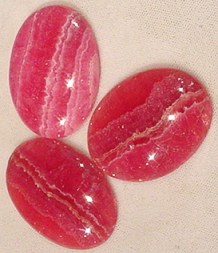
Rhodochrosite cabochons from
Argentina
|
The most important deposits are in Argentina. The rhodochrosite has formed in stalagmites in the silver mines of the Incas since they were abandoned in the 13th century. Other deposits are in Chile, Mexico, Peru, South Africa, and the U.S.
Usually used in larger pieces, as then the marking is more distinct, for ornamental objects such as cabochons, necklaces, beads, and carvings. The transparent stones are usually facetted and in demand by collectors. The largest facetted rhodochrosite with 59.65ct is from South Africa and is part of a private collection. |
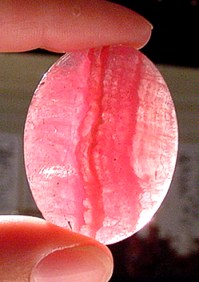
rhodochrosite cabochon
|
|
The Denver Museum of Natural History now boasts a new rhodochrosite crystal specimen, the world's largest, from the Sweet Home Mine in Park County, Colorado. (See press
release and photo below.) The 30 million year old crystal was discovered in August of 1992 in a blasted crevice 400 feet beneath Mount Boss. And its discovery occurred in front of video cameras from the museum that just happened to be there filming a mining operation! The videotape runs continuously as part of the museum's display of this specimen. If in Denver, don't miss it!
Chemical Composition: MnCo3 manganese carbonate
Hardness: 4 |
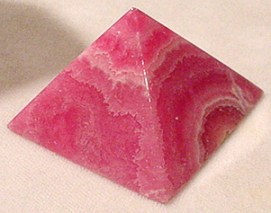
rhodochrosite pyramid
|
|
History:
Rhodochrosite was once known as Inca-rose because of the original source:
In the pre-Colombian XIII Century what is now the Northern part of Argentina was part of the Inca Empire or
Tahuantinsuyo. The mines in the region yielded silver and copper. During the rule of Inca Ripac (also called
Viracocha), the beautiful red stone was discovered. When the Inca Empire started its downfall and the Incas retired, the mine was abandoned.
In 1938 a German-born gentleman called Franz Mansfeld rediscovered the mine, in the process he also unearthed an Inca tomb, holding funerary jewelry inside it. This is how rhodochrosite was popularly re-baptized to Inca Rose or
Rosinca.
Still nowadays the Indians of the Andes believe that the blood of their ancient rulers had turned to stone there. A scientific hypothesis is that during the seven hundred years of inactivity, massive stalactitic growths had formed in the old workings, giving birth to the Ortiz quality, greatly appreciated by expert gemologists. |
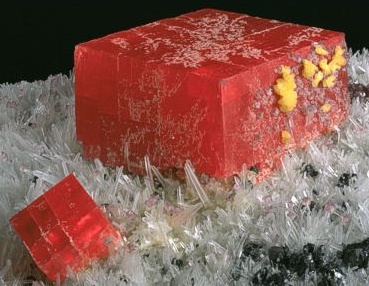
Photo by Rick Wicker; This Rhodochrosite crystal is the largest (about five
inches/12.7 cm) and most perfect specimen of its
kind in the world. It is imbedded in a spectacular
yet delicate matrix of clear quartz and fluorite
crystals (26 inch/66cm). It was a gift from the Adolph
Coors Foundation to the Coors Mineral Hall at the
Denver Museum of Nature and Science.
|
|
On April 17, 2002, Colorado Governor Bill Owens signed a bill passed by the General Assembly designating the Rhodochrosite as the new state mineral. While there was some debate as to whether the state mineral should be gold or silver or another mined mineral historically associated with Colorado, it was decided that Rhodochrosite is associated internationally with the state more than any other mineral. It is found in some gold anlver ore-bearing veins. |
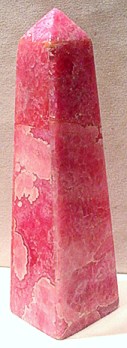
rhodochrosite obelisk
|
|
Metaphysical:
Rhodochrosite unites and balances male and female energy both within and without. It attracts the "perfect" love to the user with the intention to learn how to love. Inspires healthy love of the self and of the Earth. |
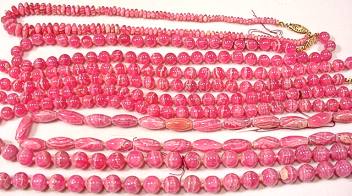
various shapes of rhodochrosite beads
|
|
A major gemstone of love, Rhodochrosite is thought to draw love to oneself, improve self-love, tolerance, gentleness and forgiveness and be especially beneficial in friendships. Natural Healers use it to increase love on all levels, including physical. It is thought to help bring balance and purify the "jaded" in love. |
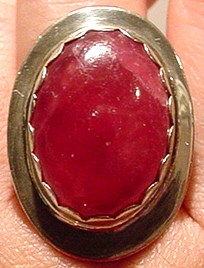
rhodochrosite ring from a private
collection
|
|
This is a high-energy stone, and is a great tool for cleaning the aura. It is a powerful fourth chakra healer, and can also be used for the first chakra. Using rhodochrosite in a female healing will help ground, align and balance a woman's energy and chakras. Matching female creative energy with the energy of rhodochrosite is a highly charged way of jump-starting the hormones. |
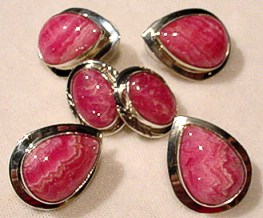
|
|
This is supposed��������� to be the
most powerful love drawing mineral there is.
Rhodochrosite attracts new love into one's life,
and helps to keep that love in balance. The
patterns remind us that life has its waves, and
so it helps to regulate life's cycles. |
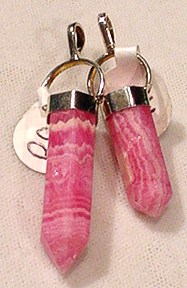
rhodochrosite pendants
|
|














